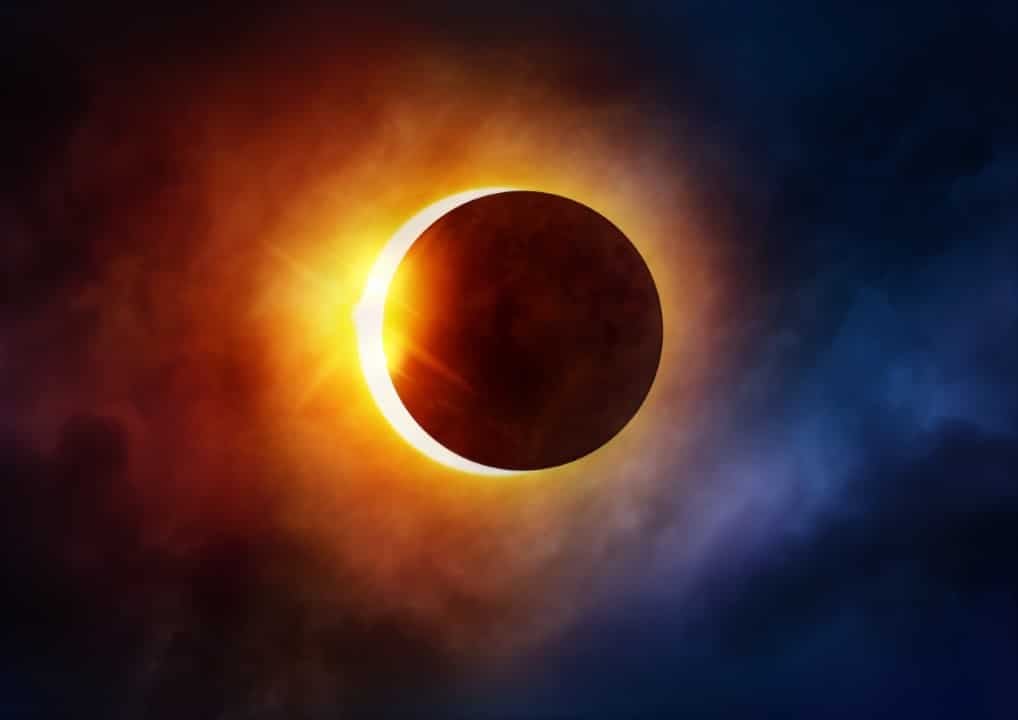
A celestial spectacle kicked off this Saturday, March 29, with the year’s first partial solar eclipse captivating viewers worldwide. Visible across multiple regions, the event drew the attention of astronomy enthusiasts and early risers as the Moon obscured part of the Sun. From Europe to northern South America, the phenomenon blended natural beauty with safety warnings, emphasizing that staring at the Sun without proper protection can lead to irreversible eye damage. In Brazil, only a small area in Amapá caught a glimpse, but live streams ensured everyone could join in.
The eclipse began at 5:50 a.m. Brasília time, peaked at 7:59 a.m., and ended at 9:34 a.m. Unlike a total eclipse, the alignment of the Sun, Moon, and Earth wasn’t perfect, resulting in a partial cover of the solar disk. Areas like the northeastern United States, eastern Canada, and parts of Europe enjoyed prime views, with the Sun partially hidden at sunrise. Astronomers note that while such events are frequent globally, they offer a rare chance to connect with the cosmos.
For many, the eclipse carried astrological weight. Occurring in Aries, it’s seen as a marker of renewal, closing a two-year cycle along the Aries-Libra axis. Whether viewed through a scientific or spiritual lens, this Saturday’s morning sky delivered a memorable moment, uniting people across continents under the same lunar shadow.
Nicely timed bit (lot) of cloud let me see the solar eclipse with my phone camera. #eclipse #eclipse pic.twitter.com/4a4uHp7aKP
— Michelle Cowbourne (@Glastomichelle) March 29, 2025
What makes this eclipse unique
In a year packed with astronomical events, this Saturday’s partial solar eclipse stands out for its broad visibility. Unlike the next solar eclipse on September 21, limited to places like Australia and Antarctica, this March event spanned five continents: North America, South America, Europe, Africa, and Asia. Its maximum magnitude reached 0.937, meaning up to 93.7% of the Sun was covered in spots like northwestern Russia, making it one of 2025’s most accessible celestial displays.
In the northeastern U.S. and eastern Canada, the eclipse aligned with sunrise, creating a striking visual known as the “devil’s horn,” where only the Sun’s edges peeked above the horizon, resembling horns due to the Moon’s shadow. In Portland, Maine, coverage hit 64%, while Washington, D.C., saw just 1%. Across the Atlantic, nations like Iceland, Ireland, and the United Kingdom caught the event at its peak during the morning hours.
In Brazil, visibility was confined to northern Amapá from 6:20 a.m. to 6:41 a.m., with minimal solar obstruction. Still, national interest surged, with live broadcasts from institutions like the National Observatory starting at 12:30 a.m., letting Brazilians follow the phenomenon in real time. This blend of science and technology bridged geographical gaps, bringing the eclipse to a wider audience.
Viewing the sky safely
Watching a solar eclipse demands caution, and this Saturday was no different. Direct exposure to sunlight, even during a partial eclipse, can permanently harm the retina. Experts stress the use of ISO 12312-2 certified glasses or indirect methods like homemade projectors using cardboard boxes. Gazing through binoculars, telescopes, or cameras without proper filters is also discouraged, as concentrated light heightens the risk.
In regions where the eclipse was visible, such as northwestern Africa and Europe, morning conditions favored observation. In Greenland’s Nuuk, the maximum occurred at 7:52 a.m., with 82.56% of the Sun covered. St. John’s, Canada, hit its peak at the same time with a similar magnitude. For those who missed it live, platforms like NASA’s YouTube channel provided a safe, detailed alternative with footage from specialized telescopes.
Eye safety isn’t just technical advice—it’s a practical necessity. During an eclipse, pupils dilate in the dimness, making eyes more vulnerable when sunlight returns. This risk is amplified in partial eclipses, as the Sun remains partially exposed throughout. Proper preparation was key to enjoying the show without health concerns.
Key times and locations
This Saturday’s partial solar eclipse traced a path across hemispheres and time zones. It started at 8:50 GMT (5:50 a.m. Brasília time), peaked at 10:47 GMT (7:59 a.m.), and concluded at 12:43 GMT (9:34 a.m.). Each area experienced it at slightly different moments based on its coordinates.
- Nuuk, Greenland: Peak at 7:52 a.m., with 82.56% coverage.
- Reykjavik, Iceland: Maximum at 9:47 a.m., with 67% obscured.
- London, United Kingdom: Peak at 10:47 a.m., with about 30% coverage.
- Lisbon, Portugal: Height at 9:47 a.m., with partial morning visibility.
- Amapá, Brazil: From 6:20 a.m. to 6:41 a.m., with slight solar dimming.
North America’s northeast U.S. and eastern Canada saw the event at dawn. In Portland, Maine, the Sun rose already eclipsed, while New York had a subtler view. In Europe, the morning timing aided visibility, especially in northwestern countries where the Moon blocked a significant portion of the Sun.
Changes beyond the sky
Beyond its visual appeal, this Saturday’s partial solar eclipse holds symbolic meaning for astrology followers. At 9 degrees Aries, it ends a cycle of eclipses along the Aries-Libra axis that began in April 2023. This period is tied to themes of individuality, relationships, and balancing self with others, with the event seen as a spark for swift shifts or resolutions brewing for months.
For Aries, Libra, Cancer, and Capricorn signs, the effects may hit harder, particularly in areas like self-assertion or partnerships. In practical terms, this could mean new ventures or the end of stagnant ties. Aries’ fiery, action-driven energy pushes bold moves, with the eclipse’s influence potentially lingering for up to six months.
Even for non-believers, the event prompts reflection. The sight of a partially covered Sun underscores the fleeting nature of cosmic cycles and the interplay of celestial bodies. Whether through science or symbolism, the eclipse fostered a shared moment that crossed cultural and geographic lines.
How the world geared up
The partial solar eclipse’s arrival spurred global preparations. In the U.S., local observatories and schools hosted viewing sessions, handing out solar filters. In cities like Boston and Philadelphia, groups gathered in parks at dawn with special glasses and DIY projectors. Anticipation was high, building on the excitement from the total lunar eclipse two weeks earlier on March 14.
Europe saw similar enthusiasm. In London, the 10:47 a.m. timing let workers and students pause to look up. In Iceland, where coverage reached 67%, hotels offered astronomy-themed packages for tourists, capitalizing on the country’s prime location. In northwestern Africa, like Rabat, Morocco, families and amateur researchers tracked the morning event.
In Brazil, despite limited visibility, online engagement shone. The National Observatory’s YouTube stream drew thousands, with real-time comments showing public curiosity. Technology played a vital role, linking those unable to see it directly with the phenomenon elsewhere.
Astronomical calendar for the year
This Saturday’s partial solar eclipse is one of many celestial highlights in 2025. The year began with a total lunar eclipse on March 13-14, visible across Brazil, turning the Moon a vivid red. With the first solar eclipse now past, more events loom, keeping skies in focus.
- September 7-8: Total lunar eclipse, visible in Europe, Asia, Africa, and Australia, but not Brazil.
- September 21: Partial solar eclipse, limited to Australia, Antarctica, and parts of the Pacific and Atlantic.
- November 5: Supermoon, with the Moon at 356,980 km from Earth, its closest approach of the year.
- Meteor showers: Highlights include the Perseids in August and Geminids in December.
This lineup showcases 2025’s astronomical variety. While September’s eclipse will be less widespread, November’s supermoon will dazzle without equipment. Each event brings its own flair, fueling ongoing interest in the stars.
Visual and cultural impacts
The Moon’s passage across the Sun this Saturday left lasting visual impressions. In eastern Canada, the eclipsed sunrise painted the horizon with dramatic orange and red hues against the lunar shadow. Photographers, amateur and pro alike, captured shots that spread quickly online.
Culturally, eclipses have long sparked awe and interpretation. Ancient societies saw them as omens, while today they inspire science and spirituality alike. In North America, some Indigenous groups link solar eclipses to renewal cycles, a notion mirrored in modern astrological views. This blend of old and new shows the sky’s enduring influence.
In Brazil, though visibility was minimal, the event boosted astronomy interest. Amapá schools held practical lessons, while elsewhere online access brought science closer. The ability to connect people through a natural phenomenon underscores eclipses’ timeless pull.
What’s next after the eclipse
With this Saturday’s spectacle over, attention shifts to 2025’s upcoming events. September’s total lunar eclipse, though not visible in Brazil, will captivate other continents with a blood Moon. The partial solar eclipse later that month, focused in the southern hemisphere, will draw eyes in Oceania and Antarctica.
Scientifically, data from this March eclipse will aid research. The Moon’s shadow on Earth helps study the solar atmosphere and light effects at various altitudes. These insights refine models of the Sun’s behavior, even when only partly obscured.
For the public, the event invites ongoing curiosity. Simple tools like solar glasses or projectors can be saved for future phenomena. Meanwhile, November’s supermoon offers an easy-to-see highlight, requiring only a clear night and a glance upward.
Eclipse fun facts
Solar eclipses are more than stunning sights; they carry stories and quirks that deepen their appeal. This Saturday’s event belongs to the Saros 149 series, a cycle repeating every 18 years, 11 days, and 8 hours, with 71 eclipses total. It began in 1664 and will end in 2926, linking generations over centuries.
- Devil’s horn: Seen in places like Canada, this effect happens when the Sun rises partially eclipsed, forming “horns” on the horizon.
- Max magnitude: This eclipse hit 0.937, never reaching 1 in partial events as the Sun stays partly visible.
- Frequency: Partial solar eclipses happen at least twice yearly somewhere on Earth.
- Polar views: Near the poles, like Greenland, the Moon’s shadow covers more of the Sun.
These traits make each eclipse distinct. Astronomical and geographic factors combine for unique experiences, from the eclipsed sunrise in the mid-Atlantic to Europe’s dimmed morning.




